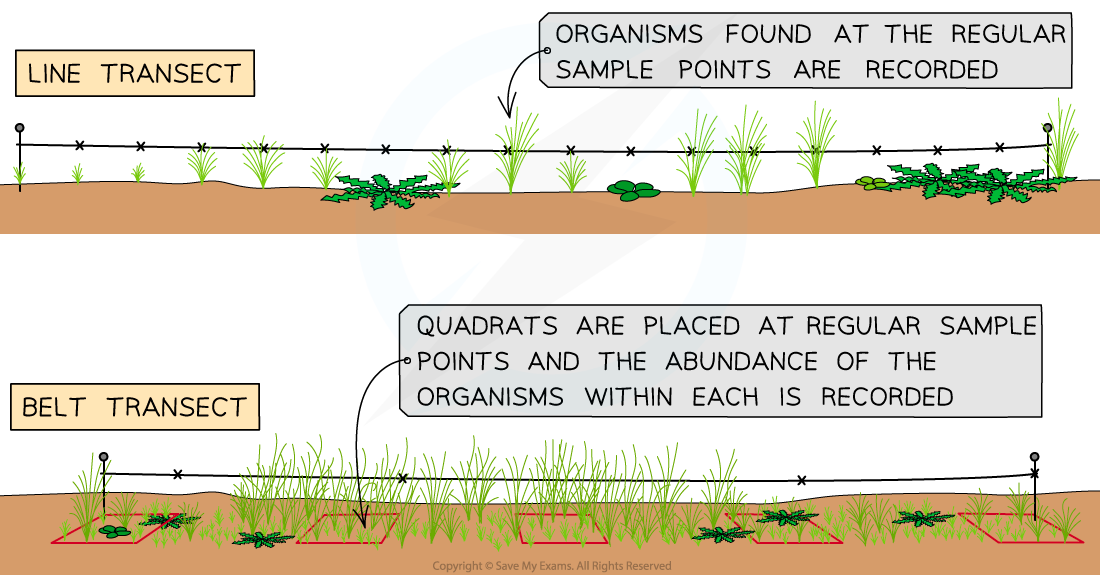Sampling to Determine Biodiversity (OCR A Level Biology): Revision Note
Exam code: H420
Sampling to Determine Biodiversity
Measuring biodiversity within an ecosystem can be challenging; in large and complex ecosystems it is simply impossible to find, identify and count every organism
For this reason sampling can be used to make an estimate of the biodiversity in an area
Sampling involves measuring biodiversity in multiple small areas within a habitat and using this information to represent the habitat as a whole; it can be used to measure:
distribution: where organisms live within a habitat
abundance: how many organisms are present
In order to be truly representative a sample must be large enough to eliminate the effects of chance, i.e. missing a species simply because it didn't happen to occur at the sample sites assessed
The more samples are collected, the more likely it is that the data will be representative of the habitat
Sampling methods can be:
random
non-random
Random sampling
In random sampling the sampling sites are selected at random; this avoids bias that might result from a researcher choosing the sites to assess
Random sample sites are often selected as follows:
a grid system is set up by laying out two long tape measures along the outer edges of a habitat
a random number generator is used to generate two random numbers
the numbers are used like graph coordinates, and the sample site is placed at the point of intersection
When a sampling area is reasonably uniform or has no clear pattern of species distribution then random sampling is the best choice

A grid system can be used to select sample sites at random
Non-random sampling
Random sampling is not always possible, or may not yield the type of results required; in these situations non-random sampling may be more appropriate
There are three main types of non-random sampling:
opportunistic sampling
Sampling is carried out on the basis of opportunity, e.g. sample sites that can be reached quickly and safely are chosen
stratified sampling
The number of random samples taken within each habitat type is proportional to the area covered by each habitat type
E.g. if 10 % of a dense woodland contains grassy clearings then 90 % of the sample locations should have tree cover and 10 % will be in clear areas
systematic sampling
Samples are taken across a habitat with reference to the changes in habitat conditions
E.g. sample sites may be taken at:
increasing altitude
increasing distance from the edge of a woodland
increasing distance from the shore line
Systematic sampling involves the use of transects
Sampling methods
Quadrat sampling
A quadrat is a square frame that is placed within the area to be studied to provide a sample
Quadrats are suitable for sampling plants or slow-moving animals
Quadrats can be different sizes depending on the species being studied
A 1 m² quadrat can be used to study small organisms such as herbaceous plants in a grassland or limpets on a rocky shore
A 400 m² quadrat can be used to study large organisms such as trees
Quadrats like this will usually be marked out with string rather than a frame!
Quadrats can be placed in a habitat randomly or along a transect
Measurements within a quadrat might include:
the number of species present
the number of individuals of a species present, i.e. species abundance
the presence/absence of a species
the percentage cover of a species, e.g. for species where it is difficult to determine where one individual ends and another starts

Quadrats are frames that can be used to sample biodiversity

Quadrats can be used to assess percentage cover when it is impossible to count all of the individual organisms
Sweeping nets
Sweeping, or sweep, nets are large, strong nets made from a material with very small holes
The nets can be swept across vegetation, e.g. grass or tree branches, to catch flying insects and insects that live on leaves
After sampling the insects in the net can be counted and identified
Pitfall traps
Pitfall traps are cans or jars that are sunk into the ground
Ground-dwelling invertebrates fall into the trap as they walk along the ground, and then cannot climb out again
A lid ensures that the trap does not fill with rainwater

Pitfall traps are used to sample ground-dwelling invertebrates
Pooters
Pooters are small plastic or glass containers with two tubes extending from the lid
The tubes can be used to suck up small invertebrates
The first tube is placed over the insect and the second tube is used by the scientist to create suction
Once inside the container the sampled organisms can be easily viewed and identified

Pooters can be used to collect small invertebrates for viewing and identification
Transects
A transect is a line along which samples can be taken
They are used during systematic sampling to assess how abundance and distribution of organisms is affected by changes in abiotic factors across a habitat
Transect lines are laid out across a habitat along the gradient that is to be investigated, e.g.
at right angles to the edge of a field
vertically up a slope
at right angles to a water course
Types of transect include:
line transect:
Lay out a measuring tape in a straight line across the sample area
At regular distances along the tape, e.g. every 1 m, record the identity of the organisms that touch the line
belt transect:
Lay out a measuring tape in a straight line across the sample area
Place quadrats at regular intervals, or continuously, along the tape and record the abundance or percentage cover of each species within each quadrat

Line and belt transects can be used to assess how the abundance and distribution of species changes across a habitat in response to an abiotic factor

Unlock more, it's free!
Did this page help you?